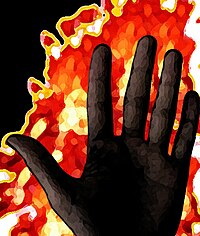|
List of planetary features with Māori namesIn the International Astronomical Union's system of unique feature names for topographic and albedo features on planets and moons in the Solar System, many are named in the language of the indigenous Māori people of New Zealand.[1] These names are primarily from Māori mythology. VenusFeatures on the planet Venus are named for women and goddesses. Colles are small hills or knobs, named after sea goddesses. Coronae are oval features of uncertain origin, named for fertility and earth goddesses. Planitiae, low plains, are mythological heroines. Tholi, small dome-like hills, are named for (miscellaneous) goddesses. Valles, valleys, are named according to their length: if more than 400 km, after the word for the planet in various world languages, otherwise after river goddesses.[2][3] 
Craters on Venus that have diameters less than 20 km are named with common female first names:[2]
Asteroids
Io The innermost moon of Jupiter, Io is a world emblazoned with the reds, yellows, whites and blacks of sulphur chemistry and the scars of active volcanism. Its features have a wide variety of naming themes: gods, goddesses and heroes associated with fire, sun, thunder, and volcanoes; mythical blacksmiths; people associated with the myth of Io; or people from Dante's Inferno. Names may also be derived from a nearby, more prominent feature; this is a situation where the same name could be used for both a volcano and an adjacent valley.[2] Montes, mountains, can be named in the Dantean or Greek categories, or for associated features. Paterae, volcanic pits with flat floors and steep walls, are named from these first two groups, and include names from their associated eruptive center. Valles, valleys, are named for their associated feature.[2][3]
Titan The largest moon of Saturn is a world in its own right: Titan has a dense atmosphere and complex weather system, with liquid-carved river networks and sizable seas. Maria, seas, are large expanses of dark materials thought to be liquid hydrocarbons; they are named for sea creatures from myth and literature. Virgae, streaks or stripes of colour, are named for rain gods and goddesses.[2][3]
TritonNeptune's largest moon is thought to be a captured Kuiper belt object, an interloper from further out in the Solar System. Triton's features are given aquatic names, excluding Roman and Greek references.[2]
References
|